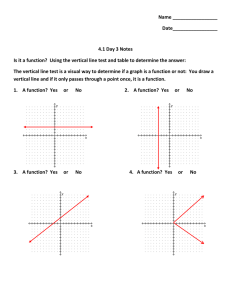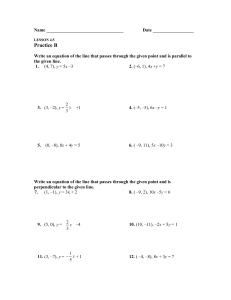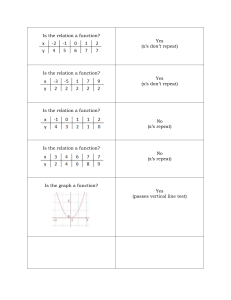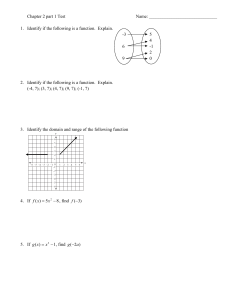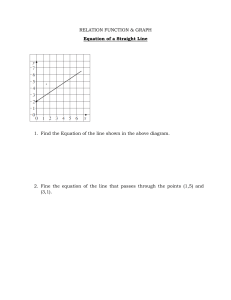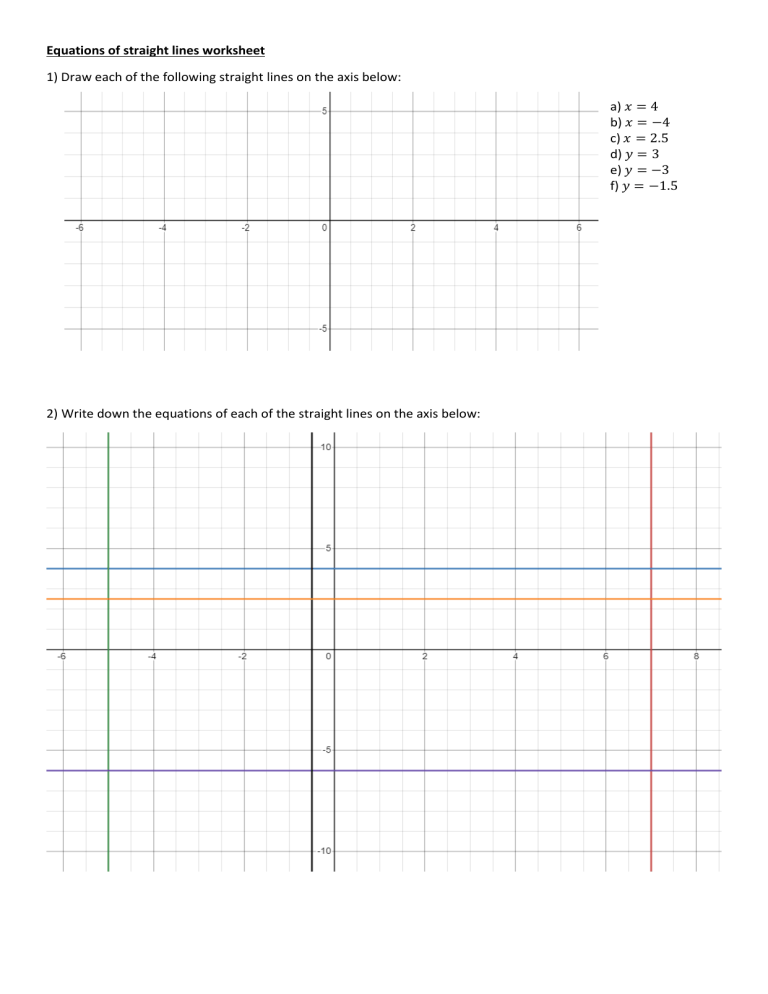
Equations of straight lines worksheet 1) Draw each of the following straight lines on the axis below: a) 𝑥 = 4 b) 𝑥 = −4 c) 𝑥 = 2.5 d) 𝑦 = 3 e) 𝑦 = −3 f) 𝑦 = −1.5 2) Write down the equations of each of the straight lines on the axis below: 3) Draw each of the following straight lines on the axes below. You may use the tables to help you: 𝑦 =𝑥+3 𝑥 −5 −2 0 1 𝑦 𝑦 =𝑥−3 𝑥 −2 0 1 3 6 𝑦 � = 2� � −2 0 0.5 2 𝑥 −6 −3 0 3 6 � 2 𝑦= 𝑥 3 𝑦 𝑦 = 3𝑥 − 1 𝑥 𝑦 −1 0 1 2 1 𝑦 = 𝑥+1 2 𝑥 −6 −4 0 2 6 𝑦 4) Draw each of the following straight lines on the axes below. You may use the tables to help you: 𝑦+𝑥 =3 𝑥 0 𝑦 0 −1 2 𝑦−𝑥 =3 𝑥 0 𝑦 0 −1 2 𝑦 + 2𝑥 = 4 𝑥 0 𝑦 0 1 − 2 3 𝑦 − 2𝑥 = 4 𝑥 0 𝑦 0 −1 1 2 𝑥 0 2𝑦 + 3𝑥 = 6 𝑦 0 4 1 − 3 2𝑦 − 3𝑥 = 6 𝑥 𝑦 0 0 −1 1 1 3 5) Find the equation of each of the straight lines on the axis below in the form 𝑦 = 𝑚𝑥 + 𝑐: 6) Find the equation of each of the straight lines on the axis below in the form 𝑎𝑥 + 𝑏𝑦 = 𝑐 7) Work out the equation of each of the following lines: a) A gradient of 4 that passes through (0, 2) b) A gradient of 4 that passes through (0, 3) c) A gradient of 3 that passes through (0, 4) d) A gradient of 3 that passes through (0, -4) e) A gradient of 3 that passes through (1, -4) k) A gradient of -⅔ that passes through (4, 3) l) A gradient of ⅔ that passes through (4, 3) m) A gradient of ⅔ that passes through (-4, 3) n) A gradient of ⅔ that passes through (-4, -3) 3 o) A gradient of 2 that passes through (-4, -3) f) A gradient of 3 that passes through (2, -4) p) A gradient of 2 that passes through (-3, -4) g) A gradient of 3 that passes through (3, -4) q) A gradient of 2 that passes through (3, -4) h) A gradient of -3 that passes through (3, 4) r) A gradient of 2 that passes through (3, 4) i) A gradient of -3 that passes through (4, 3) s) A gradient of 2 that passes through (30, 4) j) A gradient of -⅓ that passes through (4, 3) t) A gradient of that passes through (30, 40) 3 3 3 3 3 2 8) Work out the equation of each of the following lines: a) Passes through (0, 0) and (0, 4) b) Passes through (0,0) and (1, 4) c) Passes through (0, 0) and (2, 4) d) Passes through (0, 1) and (2, 4) e) Passes through (0, 2) and (2, 4) f) Passes through (1, 2) and (2, 4) g) Passes through (2, 2) and (2, 4) h) Passes through (2, 2) and (-2, 4) i) Passes through (2, 2) and (-2, -4) j) Passes through (2, 2) and (-4, -2) 9) Work out the equation of each of the following lines: a) Parallel to 𝑦 = 3𝑥 − 1 and passes through (0, 5) b) Parallel to 𝑦 = 3𝑥 − 1 and passes through (0, 4) c) Parallel to 𝑦 = 3𝑥 − 1 and passes through (0, 3) d) Parallel to 𝑦 = 3𝑥 − 1 and passes through (1, 3) e) Parallel to 𝑦 = 3𝑥 − 1 and passes through (-1, 3) f) Parallel to 3𝑦 = 𝑥 − 1 and passes through (-1, 3) g) Parallel to 3𝑦 − 𝑥 = 1 and passes through (-1, 3) h) Parallel to 3𝑦 − 𝑥 = 1 and passes through (-1, -3) i) Parallel to 3𝑦 − 𝑥 = 1 and passes through (-3, -1) j) Parallel to 3𝑦 − 𝑥 = 1 and passes through (3, 1) k) Parallel to 3𝑦 + 𝑥 = 1 and passes through (3, 1) l) Parallel to 3𝑦 + 𝑥 = 1 and passes through (6, 2) m) Parallel to 3𝑦 + 𝑥 = 1 and passes through (2, 6) n) Parallel to 3𝑦 + 𝑥 = 2 and passes through (1, 6) o) Parallel to 3𝑦 + 𝑥 = 6 and passes through (1, 2) p) Parallel to 3𝑦 + 𝑥 = 6 and passes through (2, 1) 10) Work out the equation of each of the following lines: a) Perpendicular to 𝑦 = 3𝑥 − 1 and passes through (0, 5) b) Perpendicular to 𝑦 = 3𝑥 − 1 and passes through (0, 4) c) Perpendicular to 𝑦 = 3𝑥 − 1 and passes through (0, 3) d) Perpendicular to 𝑦 = 3𝑥 − 1 and passes through (1, 3) e) Perpendicular to 𝑦 = 3𝑥 − 1 and passes through (-1, 3) f) Perpendicular to 3𝑦 = 𝑥 − 1 and passes through (-1, 3) g) Perpendicular to 3𝑦 − 𝑥 = 1 and passes through (-1, 3) h) Perpendicular to 3𝑦 − 𝑥 = 1 and passes through (-1, -3) i) Perpendicular to 3𝑦 − 𝑥 = 1 and passes through (-3, -1) j) Perpendicular to 3𝑦 − 𝑥 = 1 and passes through (3, 1) k) Perpendicular to 3𝑦 + 𝑥 = 1 and passes through (3, 1) l) Perpendicular to 3𝑦 + 𝑥 = 1 and passes through (6, 2) m) Perpendicular to 3𝑦 + 𝑥 = 1 and passes through (2, 6) n) Perpendicular to 3𝑦 + 𝑥 = 2 and passes through (1, 6) o) Perpendicular to 3𝑦 + 𝑥 = 6 and passes through (1, 2) p) Perpendicular to 3𝑦 + 𝑥 = 6 and passes through (2, 1) 11) Work out the equation of each of the following lines: a) The perpendicular bisector of the line connecting (0, 0) and (0, 2) b) The perpendicular bisector of the line connecting (0, 0) and (2, 2) c) The perpendicular bisector of the line connecting (0, 0) and (4, 2) d) The perpendicular bisector of the line connecting (0, 2) and (4, 2) e) The perpendicular bisector of the line connecting (2, 0) and (4, 2) f) The perpendicular bisector of the line connecting (-2, 0) and (4, 2) g) The perpendicular bisector of the line connecting (-2, 0) and (-4, 2) h) The perpendicular bisector of the line connecting (-2, 0) and (-4, -2) i) The perpendicular bisector of the line connecting (-2, 2) and (-4, -2) j) The perpendicular bisector of the line connecting (-2, 10) and (-4, -2) k) The perpendicular bisector of the line connecting (2, 10) and (-4, -2) l) Perpendicular to the line connecting (2, 10) and (-4, -2) that splits the line segment in the ratio 1:2 m) Perpendicular to the line connecting (20, 10) and (-4, -2) that splits the line segment in the ratio 1:2 n) Perpendicular to the line connecting (20, 10) and (-4, -2) that splits the line segment in the ratio 1:3 o) Perpendicular to the line connecting (20, 10) and (-4, -2) that splits the line segment in the ratio 3:1 p) Perpendicular to the line connecting (20, 10) and (-4, -2) that splits the line segment in the ratio 3:2 Equations of straight lines worksheet Answers 1) 2) x = 7, x = -0.5, x = -5, y = 4, y = 2.5, y = -6 3) 𝑦 =𝑥−3 𝑦 =𝑥+3 𝑥 −5 −2 0 1 𝑦 -2 1 3 4 𝑥 −2 0 1 3 6 𝑦 -5 -3 -2 0 3 � = 2� � � -4 0 1 4 −2 0 0.5 2 𝑦 = 3𝑥 − 1 𝑥 −1 0 1 2 𝑦 -4 -1 2 5 𝑥 −6 −3 0 3 6 1 𝑦= 𝑥+1 2 𝑥 −6 −4 0 2 6 2 𝑦= 𝑥 3 𝑦 -2 -1 1 2 4 𝑦 -4 -2 0 2 4 4) 𝑦+𝑥 =3 𝑥 0 3 −1 2 𝑦−𝑥 =3 𝑦 3 0 4 1 𝑥 0 -3 −1 2 𝑦 3 0 2 5 𝑦 + 2𝑥 = 4 𝑥 0 2 1 − 2 3 𝑦 − 2𝑥 = 4 𝑦 4 0 5 -2 2𝑦 + 3𝑥 = 6 𝑥 𝑦 3 0 2 0 -3 4 1 3.5 − 3 𝑥 0 -2 −1 1 2 2𝑦 − 3𝑥 = 6 𝑥 𝑦 3 0 -2 0 1.5 −1 1 5 1 3 𝑦 4 0 2 5 1 5) Orange: y = 3x, Green: y = 4x – 5, Blue: y = 2x + 1, Purple: y = 3x + 2, Black: y = -x + 5, Red: y = -½x – 3 6) Orange: 2y – 5x = 0, Green: y – 4x = -3, Blue: y – 2x = 2, Purple: 3y – x = 3, Black: y + x = 6, Red: 2y + x = -8 7) Work out the equation of each of the following lines: 2 a) A gradient of 4 that passes through (0, 2) y = 4x + 2 k) A gradient of -⅔ that passes through (4, 3) y = -3x + b) A gradient of 4 that passes through (0, 3) y = 4x + 3 l) A gradient of ⅔ that passes through (4, 3) y = x + c) A gradient of 3 that passes through (0, 4) y = 3x + 4 m) A gradient of ⅔ that passes through (-4, 3) y = x + d) A gradient of 3 that passes through (0, -4) y = 3x – 4 e) A gradient of 3 that passes through (1, -4) y = 3x – 7 f) A gradient of 3 that passes through (2, -4) y = 3x – 10 g) A gradient of 3 that passes through (3, -4) y = 3x – 13 h) A gradient of -3 that passes through (3, 4) y = -3x + 13 i) A gradient of -3 that passes through (4, 3) y = -3x + 15 1 3 j) A gradient of -⅓ that passes through (4, 3) y = - x + 13 3 2 3 2 17 3 3 2 1 n) A gradient of ⅔ that passes through (-4, -3) y = x – 3 3 3 3 o) A gradient of 2 that passes through (-4, -3) y = 2x + 3 3 3 1 p) A gradient of 2 that passes through (-3, -4) y = 2x + 2 3 3 17 q) A gradient of 2 that passes through (3, -4) y = 2x - 2 3 3 1 r) A gradient of that passes through (3, 4) y = x – 2 2 2 3 3 82 s) A gradient of 2 that passes through (30, 4) y = 2x - 2 3 3 t) A gradient of that passes through (30, 40) y = x – 5 2 2 8) Work out the equation of each of the following lines: a) Passes through (0, 0) and (0, 4) x = 0 b) Passes through (0,0) and (1, 4) y = 4x c) Passes through (0, 0) and (2, 4) y = 2x 3 d) Passes through (0, 1) and (2, 4) y = 2x + 1 e) Passes through (0, 2) and (2, 4) y = x + 2 1 3 17 3 f) Passes through (1, 2) and (2, 4) y = 2x g) Passes through (2, 2) and (2, 4) x = 2 1 h) Passes through (2, 2) and (-2, 4) y = -2x + 3 3 i) Passes through (2, 2) and (-2, -4) y = 2x – 1 2 2 j) Passes through (2, 2) and (-4, -2) y = 3x + 3 9) Work out the equation of each of the following lines: a) Parallel to 𝑦 = 3𝑥 − 1 and passes through (0, 5) y = 3x + 5 i) Parallel to 3𝑦 − 𝑥 = 1 and passes through (-3, -1) y = 1 𝑥 b) Parallel to 𝑦 = 3𝑥 − 1 and passes through (0, 4) y = 3x + 4 c) Parallel to 𝑦 = 3𝑥 − 1 and passes through (0, 3) y = 3x + 3 j) Parallel to 3𝑦 − 𝑥 = 1 and passes through (3, 1) y = 3 𝑥 d) Parallel to 𝑦 = 3𝑥 − 1 and passes through (1, 3) y = 3x e) Parallel to 𝑦 = 3𝑥 − 1 and passes through (-1, 3) y = 3x + 6 f) Parallel to 3𝑦 = 𝑥 − 1 and passes through (-1, 3) y = 1 10 𝑥+ 3 3 g) Parallel to 3𝑦 − 𝑥 = 1 and passes through (-1, 3) y = 1 10 𝑥+ 3 3 h) Parallel to 3𝑦 − 𝑥 = 1 and passes through (-1, -3) y = 1 8 𝑥–3 3 3 1 k) Parallel to 3𝑦 + 𝑥 = 1 and passes through (3, 1) y = 1 −3𝑥 + 2 l) Parallel to 3𝑦 + 𝑥 = 1 and passes through (6, 2) y = 1 − 𝑥+4 3 m) Parallel to 3𝑦 + 𝑥 = 1 and passes through (2, 6) y = 1 20 −3𝑥 + 3 n) Parallel to 3𝑦 + 𝑥 = 2 and passes through (1, 6) y = 1 19 −3𝑥 + 3 o) Parallel to 3𝑦 + 𝑥 = 6 and passes through (1, 2) y = 1 7 − 𝑥+ 3 3 p) Parallel to 3𝑦 + 𝑥 = 6 and passes through (2, 1) y = 1 5 − 𝑥+ 3 3 10) Work out the equation of each of the following lines: a) Perpendicular to 𝑦 = 3𝑥 − 1 and passes through (0, 5) y 1 = −3𝑥 + 5 b) Perpendicular to 𝑦 = 3𝑥 − 1 and passes through (0, 4) y 1 = −3𝑥 + 4 c) Perpendicular to 𝑦 = 3𝑥 − 1 and passes through (0, 3) y 1 =− 𝑥+3 3 d) Perpendicular to 𝑦 = 3𝑥 − 1 and passes through (1, 3) y 1 10 =− 𝑥+ 3 3 e) Perpendicular to 𝑦 = 3𝑥 − 1 and passes through (-1, 3) 1 8 y = −3𝑥 + 3 f) Perpendicular to 3𝑦 = 𝑥 − 1 and passes through (-1, 3) y = -3x g) Perpendicular to 3𝑦 − 𝑥 = 1 and passes through (-1, 3) y = -3x h) Perpendicular to 3𝑦 − 𝑥 = 1 and passes through (-1, -3) y = -3x – 6 i) Perpendicular to 3𝑦 − 𝑥 = 1 and passes through (-3, -1) y = -3x – 10 j) Perpendicular to 3𝑦 − 𝑥 = 1 and passes through (3, 1) y = -3x + 10 k) Perpendicular to 3𝑦 + 𝑥 = 1 and passes through (3, 1) y = 3x – 8 l) Perpendicular to 3𝑦 + 𝑥 = 1 and passes through (6, 2) y = 3x – 16 m) Perpendicular to 3𝑦 + 𝑥 = 1 and passes through (2, 6) y = 3x n) Perpendicular to 3𝑦 + 𝑥 = 2 and passes through (1, 6) y = 3x + 3 o) Perpendicular to 3𝑦 + 𝑥 = 6 and passes through (1, 2) y = 3x – 1 p) Perpendicular to 3𝑦 + 𝑥 = 6 and passes through (2, 1) y = 3x – 5 11) Work out the equation of each of the following lines: a) The perpendicular bisector of the line connecting (0, 0) and (0, 2) y = 1 b) The perpendicular bisector of the line connecting (0, 0) and (2, 2) y = -x + 2 c) The perpendicular bisector of the line connecting (0, 0) and (4, 2) y = -2x + 5 d) The perpendicular bisector of the line connecting (0, 2) and (4, 2) x = 2 e) The perpendicular bisector of the line connecting (2, 0) and (4, 2) y = -x + 4 i) The perpendicular bisector of the line connecting (-2, 2) 1 3 and (-4, -2) y = − 2x − 2 j) The perpendicular bisector of the line connecting (-2, 10) 1 7 and (-4, -2) y = − 6x + 2 k) The perpendicular bisector of the line connecting (2, 10) 1 7 and (-4, -2) y = − 2 𝑥 + 2 l) Perpendicular to the line connecting (2, 10) and (-4, -2) 1 that splits the line segment in the ratio 1:2 y = − 2 𝑥 + 1 m) Perpendicular to the line connecting (20, 10) and (-4, -2) that splits the line segment in the ratio 1:2 y = -2x + 10 f) The perpendicular bisector of the line connecting (-2, 0) and (4, 2) y = -2x + 3 g) The perpendicular bisector of the line connecting (-2, 0) and (-4, 2) y = x + 4 h) The perpendicular bisector of the line connecting (-2, 0) and (-4, -2) y = -x – 4 n) Perpendicular to the line connecting (20, 10) and (-4, -2) that splits the line segment in the ratio 1:3 y = -2x + 5 o) Perpendicular to the line connecting (20, 10) and (-4, -2) that splits the line segment in the ratio 3:1 y = -2x + 35 p) Perpendicular to the line connecting (20, 10) and (-4, -2) that splits the line segment in the ratio 3:2 y = -2x + 26
